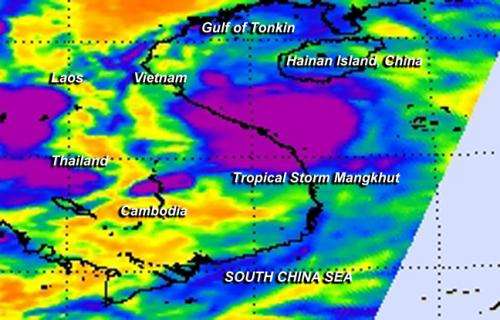NASA satellite sees Tropical Storm Mangkhut making Vietnam landfall

Tropical Storm Mangkhut had some strong thunderstorms around its center as it began making landfall in northern Vietnam on Aug. 7. Infrared data from NASA's Aqua satellite showed very cold cloud top temperatures of those strong thunderstorms as it passed overhead.
On Aug. 6 at 20:55 UTC (4:55 p.m. EDT) NASA's Aqua satellite flew over Mangkhut as it tracked west-northwest through the Gulf of Tonkin on its way to a landfall. Aqua's Atmospheric Infrared Sounder or AIRS instrument captured infrared data that showed that cloud top temperatures of some thunderstorms around Mangkhut's center were as cold as 210 kelvin/-81F/-63C indicating powerful storms with the potential for heavy rainfall.
The AIRS data also measures temperatures over land, and in the same image where it captured Tropical Storm Mangkhut, the data showed some of the surface temperatures in eastern central China appeared warmer than 300 kelvin/80F/26.8C at 1841 UTC on Aug. 6 or 2:41 a.m. China local time. Those are warm overnight temperatures!
Early on Aug. 7, the Joint Typhoon Warning Center noted that "Animated infrared satellite imagery shows the deep convective bands associated with the system have collapsed as they began to interact with the topography of Vietnam." A Tropical Storm Warning remains in effect for Aug. 7, according to the Vietnam National Centre for Hydro-Meteorological Forecasting.
At 1500 UTC (11 a.m. EDT) on Aug. 7, Mangkhut's center was very close to landfall. Maximum sustained winds were near 35 knots, making it a minimal tropical storm. Mangkhut was about 92 nautical miles/106 miles/170 km south of Hanoi, Vietnam, near 19.8 north latitude and 105.8 east longitude. It was moving to the west-northwest at 13 knots/15 mph/24 kph.
After Mangkhut makes landfall about 65 miles south of Hanoi, the storm is expected to dissipate within 24 hours.
Provided by NASA's Goddard Space Flight Center





















